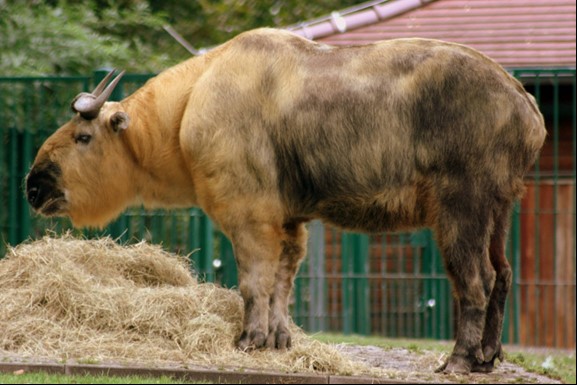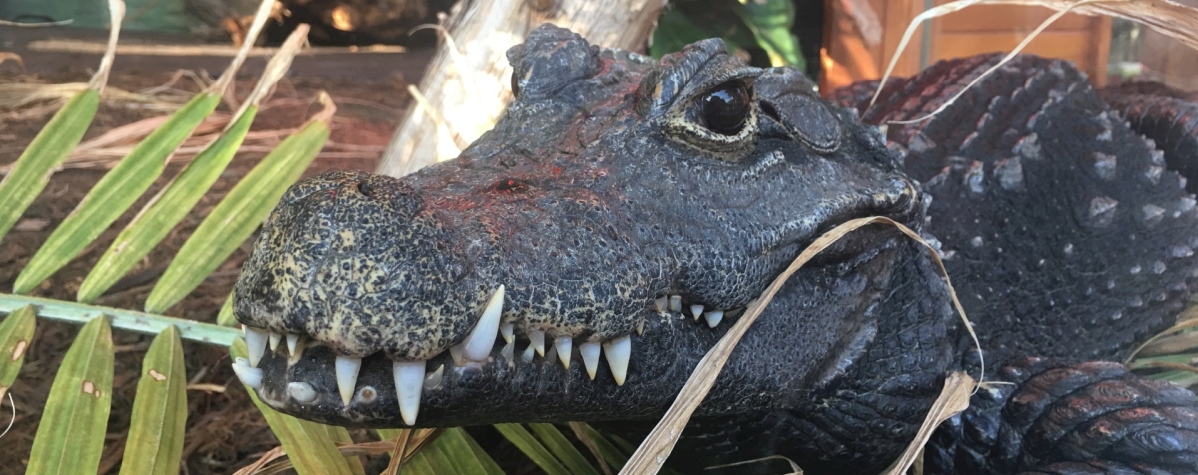Sichuan Takin
Scientific Classification 
| Species |
Budorcas taxicolor tibentana |
| Kingdom | Animalia |
| Phylum | Chordata |
| Class | Mammalia |
| Order | Artiodactyla |
| Family | Bovidae |
| IUCN Status | Vulnerable |
Appearance and lifespan
The Sichuan Takin male weighs up to 350kg (770 lbs), while females weigh less than 294kg (650 lbs). At shoulder height, they measure roughly 1.3m (4.2 ft) off the ground and about 6 feet in length.
Takins are golden in colour and appear to have the horns of a wildebeest, the nose of a moose and the body of a bison. These giant hoofed animals are most closely related to the Barbary sheep, although they are often referred to as goat-antelope since they share so many similar characteristics. Adult takins have black crescent-shaped horns that grow from the centre of its head. They can grow up to 90 cm (35 in) long!
Sichuan takins live between 16 to 18 years in the wild, and up to 20 years in captivity.
Behavior and reproduction
Herding habits differ depending on the season for these animals. In spring and early summer their herds can reach numbers as high as 300 since food is so plentiful. During the harsher seasons and cooler months, the herd breaks into smaller packs of roughly 10 to 35 takins. This is when they move further down the mountain to escape the colder temperatures. The herds consist of females, kids, adults and young males—while dominant males usually travel alone.
The dominant males will only regroup with the rest of the herd during mating season. Scientists have never observed breeding activity in the wild.
Takin calves are darker in colour to camouflage themselves better from predators. They even have a dark stripe down their spine; however, their pelts get lighter and more golden as they grow older. Maturity is reached at the age of 2 years.
Ecology and habitat
Takins live in dense bamboo forests in the cold Himalayan Mountains. The air is so cold there that they must come up with many adaptations to survive! Their big noses are used to warm up the air before they inhale it, and they sport heavy secondary coats during the winter. Their very oily skin also helps in extra protection during rainstorms and dense fog. Due to the rocky terrain, they have split hooves to better maneuver around the uneven surface.
Sichuan takins eat almost 100 different kinds of vegetation, especially bamboo. They are capable of stripping leaves off trees 2.4m (8 ft) off the ground by standing up on a tree and browse on its leaves.
Food at the Zoo
The takins are fed hay, browser pellets, apples and carrots at Riverview Park and Zoo. We also provide salt blocks in their enclosure and provide browse.
Threats
Illegal poaching combined with habitat loss has put the Sichuan Takin’s safety into question. In the 1970’s, China began devoting protected land for takin's. Although some strides have been taken in their conservation, it is still pertinent to understand their life history, ecology and habits better to truly help in the long-term.
Did you know?
- The takin, along with the giant panda, are considered national treasures to the Chinese.
- Takin are ruminants, meaning they regurgitate their food and use microbes in their gut to help digest food.
- Takins sleep with their heads resting on top of their extended front feet, just like a dog!
- The Sichuan takin here at Riverview Park and Zoo are part of a Species Survival Plan, which helps to ensure healthy numbers of certain species of animals in captivity in order to prevent extinction!
Adopt the takin
Become a part of the the Riverview Park and Zoo family through our Adopt an Animal Program!


